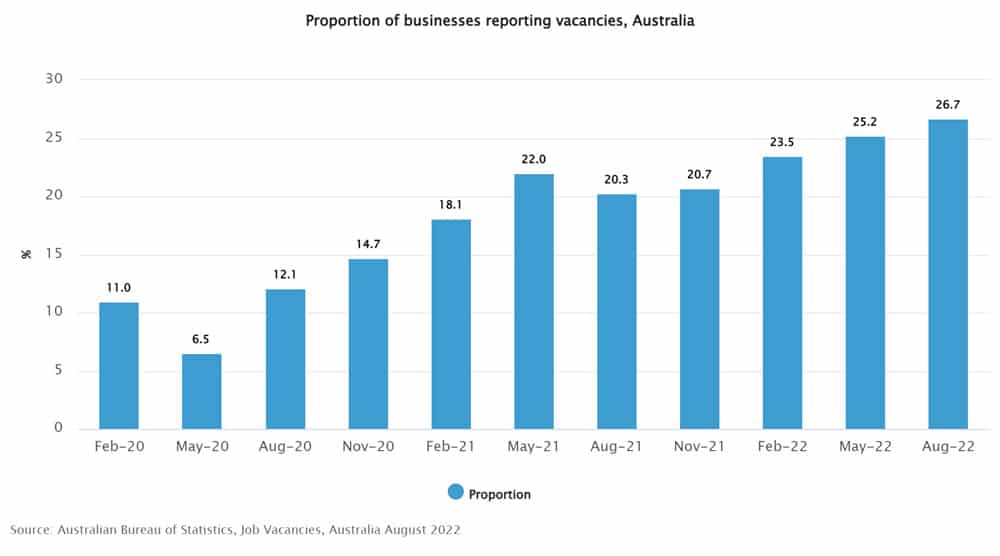As you have probably noticed, it’s a tough job market right now. Not for employees – who are being courted like never before – but for employers, many of whom just can’t find or hold on to quality contact centre and customer service staff.
There are a lot of reasons for this sudden shortage of skills and experience that is affecting almost every industry in Australia and New Zealand, but is hitting contact centres in particular very hard.
Whether that’s because of reduced immigration due to our closed borders, or people leaving the workforce early to pursue their dreams, or more competition from other service industries like hospitality and travel, it doesn’t really matter.
You just want to know what to do about it.
You’re not alone
According to contact centre employers we’ve spoken with, many are running as much as 20% below FTE capacity. Job vacancy rates across Australia are nearly 3 times higher than they were in February 2020, just before the pandemic, with 27% of employers reporting vacancies in the August 2022 quarter.

The Administration & Support Services sector, which includes contact centres, is one of the hardest hit, with 33% of businesses reporting vacancies – double the pre-pandemic figure. Only hospitality, accommodation, public sector administration, and healthcare report higher vacancy rates.
Which all goes to show that, if your contact centre is having difficulty sourcing and holding on to staff, the problem isn’t yours alone.
Don’t let staff shortages hold you back, here are 4 alternatives to hiring …
If your contact centre is understaffed, you don’t need us to tell you what the likely consequences might be: Lost business and dissatisfied customers if you can’t answer their calls; stressed out staff as you ask them to pick up the slack, making them only more likely to leave; and thwarted revenue and growth goals as you just lack the resources to keep up with demand.
You have likely already tried upping your recruitment efforts and ad spend. You might have engaged one or two recruitment agencies. And you have probably offered incentives to your existing staff to refer friends and family.
To keep hold of your existing people – which is more crucial than ever as you can’t easily replace them – you have probably increased pay and offered more flexible working conditions. Studies show that providing a friendly working culture, training and skills development, and career progression opportunities to staff are also big drivers of retention – so hopefully you have tried those things too.
But if you’re still understaffed, and your retention rate is nowhere near where you want it to be, what other options do you have?
Let’s look at how you can solve your staff shortage problem without hiring anyone.
Option 1: Divert calls to digital and self-service channels
We have a whole separate article on this, but the basic idea is that you can handle more customer interactions with fewer people if you drive customers to more efficient channels than the telephone. For example, one customer service agent can handle 3 or 4 live chat sessions simultaneously. You can also find more ways for customers to help themselves, including FAQs, chatbots, IVR self-service, customer portals, etc.
You have to be careful about how you divert customers away from the voice channel, as you don’t want to come across like you don’t want to talk to them. But if you do it right, and always give customers an option to escalate to a live agent if they get stuck, you can actually improve customer satisfaction while reducing the resources you need.
You can also further reduce your call volumes by improving your First Call Resolution rate and reducing errors, meaning customers don’t have to call back multiple times to solve their issue. Proactively notifying customers about progress with their order or query also cuts down on repeat calls.
Option 2: Get more productive
This amounts to doing more with the resources you already have. If, for example, you have budget to invest in more people but can’t use it because you can’t hire, then you could divert that investment into software and other tools that make you more productive.
For example, upgrading to a cloud contact centre platform will allow you to offer genuine omnichannel customer service and support to your customers, which hugely increases efficiency. It can also enable you to offer more flexible and home working roles, opening up your jobs to home workers outside of your usual catchment areas.
You can also invest in agent empowerment tools like an agent desktop or workflow software. These allow agents to interact with multiple systems and data sources from a single interface, which can dramatically reduce hold time, wrap time and average handling time (AHT). Knowledge base software that provides agents with context-sensitive customer information or tips on what actions to take next can also improve a host of efficiency metrics.
Option 3: Partner with a BPO (business process outsourcer)
We have several articles about the different contact centre outsourcing options available to businesses that are having trouble keeping up with customer demand. These include diverting overflow calls to a BPO partner, or even outsourcing parts of your operation offshore.
An overflow partner helps take the load off your contact centre when volumes peak or when you are just understaffed. They can either provide a simple message-taking service, handle just your simple queries, or be trained to replicate exactly what your in-house staff do so your customers have no idea they’re speaking to someone in an outsourced centre.
Outsourcing all or part of your customer service and support operation can be a daunting prospect, particularly if you’ve never outsourced before. After all, your customer relationships are among the most valuable assets your business has, so why trust them to someone else? The answer is, for the same reason you rely on outside parties to manage other critical parts of your business – they are experts at it. A contact centre outsourcing company does nothing but manage customer relationships on behalf of lots of different companies.
BPOs do much more than take over the management of customer relationships, they can also be commercially incentivised to improve your whole operation and their remuneration can be linked to the results they deliver. The payoffs for outsourcing your contact centre should be improved customer satisfaction and customer retention rates, increased sales and revenues from providing a better service, and reduced costs from productivity and efficiency gains.
These are the benefits you should be expecting, whether you outsource to a domestic or offshore BPO. Offshore in theory enables you to reduce your costs even further.
Option 4: Staff leasing and co-sourcing
OK, so this option doesn’t strictly involve no hiring – it’s just you don’t hire people directly. The staff leasing model is a great option if you only need to hire a handful of people and you’re quite happy to manage them yourself, as if they were your own staff.
A BPO or staff leasing company can either recruit for you, according to the roles and skills profiles you need to fill, or provide you with experienced and qualified people from their own staff pool either permanently or on a temporary basis. The benefits are that you don’t have to spend time and money recruiting staff yourself. As the staff remain employed by your partner, not you, you don’t incur any HR, payroll and admin overheads.
In a co-sourcing model staff can be based in your partner’s office or contact centre, which could be in Australia or offshore, or they could work from home, or from your own offices alongside your own employees. There are many flexible options that can get you the headcount you need quickly, with the peace of mind that your new hires have the skills and experience you need. (And if they do not, the liability for letting them go is with your partner, not with you).
What options are best for you?
Which of the above options is best for your contact centre depends on your industry, your growth goals, and how short-staffed you are. If your staff shortage challenges are deep-rooted and ongoing you might want to consider completely outsourcing your operation. If you just need to increase your FTE to handle a peak in customer demand then overflow handling might be what you’re looking for.
Whatever option is right for your business, you don’t need to take the current staff shortage situation on the chin. Nobody knows when, or indeed if, the Australian job market will return to normal. It is likely that many of the changes brought about by the pandemic, such as the move to flexible and hybrid working, are here to stay. We would advise you not to attempt to make do and ride the storm out. It could be very damaging for your business and its growth goals. Instead, assess your options for overcoming staff shortages without hiring today.


















